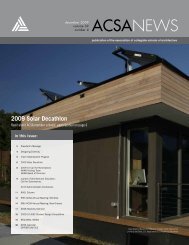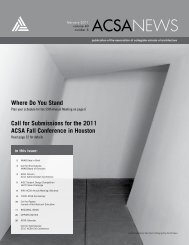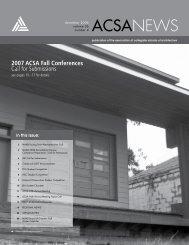digital aptitudes - Association of Collegiate Schools of Architecture
digital aptitudes - Association of Collegiate Schools of Architecture
digital aptitudes - Association of Collegiate Schools of Architecture
You also want an ePaper? Increase the reach of your titles
YUMPU automatically turns print PDFs into web optimized ePapers that Google loves.
SATURDAY, MARCH 3, 2012 - 4:00PM - 5:30PM<br />
Teaching History in the Digital Age<br />
Carla Keyvanian, Auburn University<br />
Building Socialistic Architectural <strong>Schools</strong>: The<br />
Transformation <strong>of</strong> China’s Architectural Education<br />
from American Beaux-Arts Model into the Soviet Model<br />
Xiao Hu, University <strong>of</strong> Idaho<br />
The pr<strong>of</strong>essional education is a vital component <strong>of</strong> the architectural<br />
pr<strong>of</strong>ession. It not only <strong>of</strong>fers special training to obtain the required<br />
basis <strong>of</strong> architectural knowledge and skills needed for the<br />
pr<strong>of</strong>essional practice <strong>of</strong> design, but also ensures the stable development<br />
<strong>of</strong> the pr<strong>of</strong>ession by excluding other competitors through<br />
a monopoly <strong>of</strong> knowledge and skills. The required formal training<br />
<strong>of</strong> architecture provides a cultural and social legitimation for architects’<br />
responsibility and importance.<br />
The formation <strong>of</strong> the modern architectural pr<strong>of</strong>ession in China was<br />
the product <strong>of</strong> political and social change – the falling <strong>of</strong> China’s<br />
imperial system and the rising <strong>of</strong> Western capitalism in the end<br />
<strong>of</strong> 19th Century. The introduction <strong>of</strong> modern Western capitalist<br />
forces <strong>of</strong> production had undermined and transformed much <strong>of</strong><br />
China’s traditional economic order, and the onslaught <strong>of</strong> the Western<br />
model disintegrated China’s traditional architectural practices.<br />
However, the architectural pr<strong>of</strong>ession in China was not refashioned<br />
in the image <strong>of</strong> the Western pr<strong>of</strong>essional world. Although Chinese<br />
architects shared the similar, if not the same, pr<strong>of</strong>essional criteria<br />
and social distinction with those practitioners in the West, the<br />
changeable ideological structures, repeated foreign interventions,<br />
and constant revolutions significantly changed the nature <strong>of</strong> the architectural<br />
practice in China. In the 1950s, China’s architectural education<br />
underwent a significant transformation under political and<br />
ideological orders. Within a few years, the American Beaux-Arts<br />
model was wiped <strong>of</strong>f and was replaced by the model borrowed<br />
from the Soviet Union. This paper focuses on how the Chinese<br />
Communist Party effectively implemented its plans and policies<br />
step by step to complete this transformation.<br />
On the Use Value <strong>of</strong> History<br />
Amir Ameri, University <strong>of</strong> Colorado<br />
The <strong>digital</strong> information revolution and the economic globalization<br />
it has greatly facilitated have brought diverse cultures into unprecedented<br />
proximity and a precarious dialogue in both actual and<br />
virtual space and time. This cohabitation is transforming world cultures<br />
at a scale and a rate that is impressive, if not unprecedented.<br />
The question and challenge this change poses architectural education<br />
is how to educate the next generation <strong>of</strong> architects to meet<br />
the unique demands <strong>of</strong> a plurality <strong>of</strong> cultures in a state <strong>of</strong> flux and<br />
change? To meet this challenge architectural education has to instil<br />
a heightened understanding <strong>of</strong> the complex dialogue between<br />
architecture and culture, along with a spirit <strong>of</strong> critical exploration,<br />
experimentation, creative thought, and innovation. The history <strong>of</strong><br />
<strong>Architecture</strong> will have an indispensable role to play in any curriculum<br />
that seeks to meet these challenges. Yet, to play a pivotal role<br />
in fostering the requisite spirit <strong>of</strong> critical exploration and innovation,<br />
architectural history has to engage and exert a critical impact<br />
on studio pedagogy. Since secular institutional building-types are<br />
the core focus <strong>of</strong> design studio instruction, architectural history<br />
has to more directly engage the history <strong>of</strong> their cultural and institutional<br />
development. Such genealogical studies can establish a direct<br />
link between history and design pedagogy as complimentary<br />
practices. To demonstrate, I focus on the history <strong>of</strong> the library and<br />
point out how a critical re-evaluation <strong>of</strong> its ideological underpinnings<br />
can form the parameters <strong>of</strong> a new context for design, within<br />
which the link between the formal/architectural properties <strong>of</strong> the<br />
building type and its institutional/cultural presuppositions could<br />
neither be restated nor discarded. This new context will require<br />
students to not only think analytically and critically, but also to wilfully<br />
manipulate the language <strong>of</strong> architecture as opposed to faithfully<br />
re-produce its various speech acts.<br />
Transparency: Literal, Phenomenal, Digtial<br />
Newton D’souza, University <strong>of</strong> Missouri-Columbia<br />
Bimal Balakrishnan, University <strong>of</strong> Missouri-Columbia<br />
James Dicker, University <strong>of</strong> Wisconsin-Milwaukee<br />
Our proposal consists <strong>of</strong> a reframing <strong>of</strong> <strong>digital</strong> tools that moves<br />
away from its current usage as ‘tools for design’ to ‘tools <strong>of</strong> design.’<br />
Using a prominent historic example in the architectural discourse,<br />
namely phenomenal transparency (Rowe and Slutzky 1963; 1971),<br />
we will demonstrate how this reframing might be possible, and illustrate<br />
the affordances <strong>of</strong> <strong>digital</strong> tools in the pedagogy <strong>of</strong> history<br />
and design.<br />
We recognize that the current <strong>digital</strong> tools were born in disciplines<br />
outside architecture and thereby divorced from its intellectual core.<br />
We believe that intellectual core consists <strong>of</strong> moving away from the<br />
practice <strong>of</strong> architecture as an expressive content (fabrication and<br />
manufacturing), and moving toward the practice <strong>of</strong> intrinsic content<br />
(visual vocabularies, ‘what-if’ design scenarios, and a corpus<br />
<strong>of</strong> mutually dependent representative network). Digital tools can<br />
be reframed to facilitate such an intellectual core because <strong>of</strong> their<br />
affordance <strong>of</strong> a shared, holistic, structured and replicable environment.<br />
This has implications to the pedagogy <strong>of</strong> history and design and<br />
more importantly to strengthen the history-design studio axis. It<br />
will comprise <strong>of</strong> an approach that conceptualizes history as a problem-solving<br />
domain, and one which becomes available for a shared<br />
scrutiny. Rather than a mere accumulation <strong>of</strong> explicit knowledge,<br />
this approach allows for dissecting the process in varied ways, facilitating<br />
cross-comparison, learning how recurring problems were<br />
solved in the past, and revealing hitherto hidden elements. These<br />
historic lessons can then be extended to design studios through<br />
exploratory exercises that allow designers to launch with conviction<br />
creative and intellectually stimulating design scenarios.<br />
Digital Apptitutes + Other Openings - Boston, MA - 33








